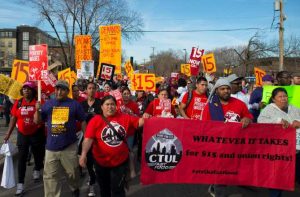By Dave Lindorff

Economists say they are stumped by a mystery: Since the US economy is doing so well, and unemployment is down to below 4%, which many argue is close to “full employment” in historic US terms, why is it that wages are not growing, and in fact, are lower in real dollars than they were in 1974, almost half a century ago.
Reading articles like these in news reports ranging from NPR to the New York Times to the Economist magazine in the UK, is a good source for some laughs.
These poor financial journalists and the economists they quote as their sources are all struggling because because their models, and everything they learned in school about market theory, says that if labor markets are“tight,” meaning that there are few jobs available to unemployed workers, it should drive up wages of those who have jobs, because employers would have a hard time replacing workers who ask for more money.
Perhaps in some magic world where workers and bosses were operating basically as equals in some mystical“free marketplace,” that might be true, but it ignores things like power relations and labor law, the pernicious role of the new digital age where a worker’s employment record is immediately available for inspection by any potential new employer, and of course the existence of an asymetric “global” economy which allows for the virtually free flow across borders of goods and especially investment capital, but that tightly restricts the flow of labor (that is, workers cannot just up and move to another country where pay and working conditions are better).
Add to that the reality that statistics upon which economists base their views are developed and reported by a government that is almost totally in the pocket of the bosses. So when, for example, the Bureau of Labor Statistics says that unemployment is down to just 3.9 percent, that agency is using a definition of unemployment which has been changed multiple times over the years, always in a direction of reducing that number from what would it have been under an earlier definition. Basically the BLS defines the unemployment rate as the number of people who want a job and cannot find one (that’s the numerator), divided by the number of people who are “in the labor force” (the denominator). But the BLS today restricts its definition of “in the labor force” to meaning just those who either have a job, or who may not have a job but looked for one at least once during the prior four weeks. Being employed meanwhile, is currently defined broadly as anyone who has worked as little as one hour during the prior to the survey! One hour!
No wonder unemployment in the US is reported as being so low these days…
For the rest of this article by DAVE LINDORFF in ThisCantBeHappening!, the uncompromised, collectively run, six-time Project Censored Award-winning online journalism news site, please to to: www.thiscantbehappening.net/node/3940

